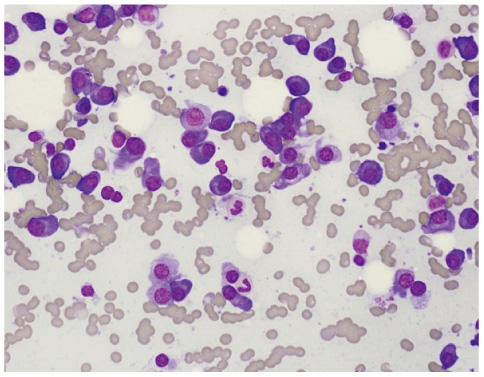Lab Med Online.
2011 Jul;1(3):158-162.
Immunoglobulin Isotype Switching in a Plasma Cell Myeloma Patient Treated with High-dose Chemotherapy and Hematopoietic Stem Cell Transplantation
- Affiliations
-
- 1Department of Clinical Pathology, Kyungpook National University School of Medicine, Daegu, Korea. kesong@knu.ac.kr
Abstract
- A malignant plasma cell clone usually produces a single abnormal monoclonal protein with a constant isotype. However, switching of paraprotein isotype has been reported to be a transient phenomenon associated with the recovery of B-cell function, and, in some cases, the switching might be misinterpreted as relapse. In August 2008, we encountered a case of a 59-year-old man with proteinuria and high IgG level (5.6 g/dL), kappa free light chain level of 2,660 mg/L, reversed A/G ratio (0.51), and multiple osteolytic lesions. Plasma cells, which accounted for 57% of all the nucleated cells, in bone marrow aspirates were positive for kappa immunostaining. Serum protein electrophoresis showed one M-spike, concentration of 4.87 g/dL in the beta region. Immunofixation electrophoresis revealed the peak as an IgG-kappa monoclonal protein; therefore, a diagnosis of plasma cell myeloma was made. Complete remission was achieved after chemotherapy, and autologous peripheral stem cell collection was performed. In March 2009, the patient underwent high-dose chemotherapy and autologous peripheral stem cell transplantation support. After 2 months, serum protein electrophoresis showed 2 M-spikes in the gamma region with positive IgM-lambda, IgG-lambda, and IgG-kappa, and these bands persisted. The electrophoretic mobility of the IgG-kappa protein was different from that of the original disease protein, and bone marrow results were the same as the previous ones. Although immunoglobulin isotype switch is known to have a benign course, it always requires careful monitoring because, in rare cases, true clonal switching may occur.
Keyword
MeSH Terms
-
B-Lymphocytes
Bone Marrow
Clone Cells
Electrophoresis
Hematopoietic Stem Cell Transplantation
Hematopoietic Stem Cells
Humans
Immunoglobulin Class Switching
Immunoglobulin G
Immunoglobulins
Light
Middle Aged
Multiple Myeloma
Peripheral Blood Stem Cell Transplantation
Plasma
Plasma Cells
Proteinuria
Recurrence
Stem Cells
Immunoglobulin G
Immunoglobulins
Figure
Reference
-
1. Butch AW, Badros A, Desikan KR, Munshi NC. Expression of a free gamma heavy chain in serum following autologous stem cell transplantation for IgG-kappa multiple myeloma. Bone Marrow Transplant. 2001. 27:663–666.
Article2. Alejandre ME, Madalena LB, Pavlovsky MA, Facio ML, Corrado C, Milone G, et al. Oligoclonal bands and immunoglobulin isotype switch during monitoring of patients with multiple myeloma and autologous hematopoietic cell transplantation: a 16-year experience. Clin Chem Lab Med. 2010. 48:727–731.
Article3. Hall SL, Tate J, Gill D, Mollee P. Significance of abnormal protein bands in patients with multiple myeloma following autologous stem cell transplantation. Clin Biochem Rev. 2009. 30:113–118.4. Zent CS, Wilson CS, Tricot G, Jagannath S, Siegel D, Desikan KR, et al. Oligoclonal protein bands and Ig isotype switching in multiple myeloma treated with high-dose therapy and hematopoietic cell transplantation. Blood. 1998. 91:3518–3523.
Article5. Reiman T, Seeberger K, Taylor BJ, Szczepek AJ, Hanson J, Mant MJ, et al. Persistent preswitch clonotypic myeloma cells correlate with decreased survival: evidence for isotype switching within the myeloma clone. Blood. 2001. 98:2791–2799.
Article6. Maisnar V, Tichý M, Smolej L, Zák P, Radocha J, Palicka V, et al. Isotype class switching after transplantation in multiple myeloma. Neoplasma. 2007. 54:225–228.7. Hovenga S, de Wolf JT, Guikema JE, Klip H, Smit JW, Siinga CS, et al. Autologous stem cell transplantation in multiple myeloma after VAD and EDAP courses: a high incidence of oligoclonal serum Igs post transplantation. Bone Marrow Transplant. 2000. 25:723–728.
Article8. Yoon CE, Lee JK, Hong YJ, Hong SI, Kang HJ, Chang YH. Oligoclonal bands in patients with multiple myeloma after autologous peripheral blood stem cell transplantation. Korean J Lab Med. 2010. 30:S. S468–S469.9. Alegre A, Granda A, Martinez-Chamorro C, Diaz-Mediavilla J, Martinez R, Garcia-Laraña J, et al. Different patterns of relapse after autologous peripheral blood stem cell transplantation in multiple myeloma: clinical results of 280 cases from the Spanish registry. Haematologica. 2002. 87:609–614.10. Guikema JE, Vellenga E, Veeneman JM, Hovenga S, Bakkus MH, Klip H, et al. Multiple myeloma related cells in patients undergoing autologous peripheral blood stem cell transplantation. Br J Haematol. 1999. 104:748–754.
Article
- Full Text Links
- Actions
-
Cited
- CITED
-
- Close
- Share
- Similar articles
-
- HBV reactivation in a HBsAg-negative patient with multiple myeloma treated with prednisolone maintenance therapy after autologous HSCT
- Nonmyeloablative stem cell transplantation
- A Case of Cerebral Toxoplasmosis Following Tandem Autologous Stem Cell Transplantation in a Multiple Myeloma Patient
- Opening the era of in vivo xenotransplantation model for hematopoietic stem cell transplantation
- Reverse Seroconversion of Hepatitis B following Allogenic Hematopoietic Stem Cell Transplantation from a Hepatitis Immune Donor in a Multiple Myeloma Patient



